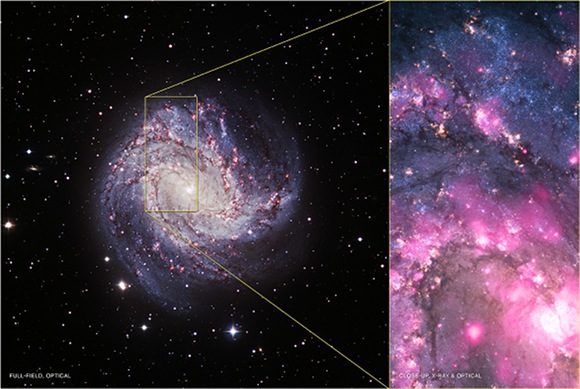Original URL: https://www.theregister.com/2012/05/03/black_hole_x_ray_outbursts/
Crazy old black hole's X-ray ultra-belch makes galaxy blush
Space telescope sniffs outburst more powerful than MILLION Suns
Posted in Science, 3rd May 2012 13:02 GMT
A powerful blast of X-rays - equivalent to the energy emitted by a MILLION Suns - has been fired out of a black hole in the spiral galaxy M83, lighting up the space around it.

Credit: Left: ESO/VLT and NASA/CXC/Curtin University/R. Sorla. Right: NASA/STScl/Middlebury College/F. Winkler et al.
Over several years, NASA's Chandra X-ray Observatory has focused on the ultra-luminous X-ray source (ULX), so called because it's pumping out more rays than "normal" binary systems in which a companion star orbits what's left of a collapsed star. This particular ULX, located in a system 15 million light years from Earth, increased its black hole's X-ray brightness by at least 3,000 times.
The sudden uptick in radiation is one of the largest changes in X-rays ever seen for a ULX, which normally don't have dormant periods.
Optical images show a radiant blue source during the X-ray outburst, which was nowhere to be seen before the beaming began, indicating that the black hole's companion is a red giant star.
The black hole's bosom buddy is more than 500 million years old with a mass less than four times the mass of the Sun. Boffins reckon the bright blue emission during the X-ray outburst is the old red's doing because it's caused by a disk around the black hole that glows furiously as it gains more material from the star.
Another flip-flopping ULX was also found in M31 galaxy, and the two together lend weight to the argument that ULX black holes can be much older and more volatile than previously thought.
This black hole could have been formed from a star rich in "metals" - which are any elements heavier than helium - because it's located in a region that's abundant with the stuff. The black hole is also the wrong size for current theoretical models.
Theories suggest that stars packed with metals have a higher mass-loss rate, making them smaller before they collapse so that the resulting black hole is also small. Stars that have collapsed with high metal content are only supposed to be about 15 times smaller than the Sun or more.
However, this black hole could also be so old that it formed before the time that M83 became rich in heavier elements, which would also explain its size. ®